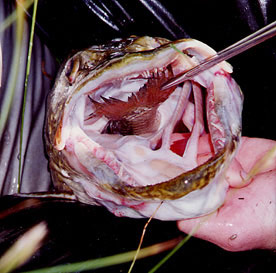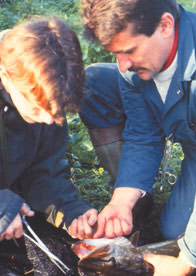 |  |  |
| HOME | CONTENTS | JOIN HERE | |||||
| ABOUT
PAC | |||||||
|
On some occasions the act of pulling on the trace will result in the bait (which is almost always still attached to the hooks when a pike has swallowed it) simply popping out of the pike's throat - hooks and all. This is not always the case, but in any event if you can see the bait it is always a good idea to grip it with a pair of strong forceps and try to pull it out before starting to remove the hooks. Getting the bait out of the way makes it much easier to see what you are doing when operating on the hooks.
If the problem trace is not yours it is unlikely you'll have a clue where the hooks are if none are visible but you should still try the above procedure. If the trace has already been cut pull the cut end with forceps. If this is not possible, cut and remove as much of the hooks/trace as you can and release the fish. It is reasonable to conclude that hooks left in a pike will eventually disintegrate by a combination of digestion and rusting (assuming that stainless steel hooks have not been used and for this reason they should not be). Whenever possible attempts should be made to remove any and all hooks. Should you be fishing alone, pull the line or braid with your teeth to raise the hooks up. If there is no line attached to the trace then a piece of leather, or a pad of other material, can be attached to the swivel by means of something resembling a paper clip and this again pulled using your teeth. Be ready for any sudden movement of the fish though! Do not forget that you are dealing with a living creature and time is of the essence. It may even pay to interrupt proceedings by putting the pike in the margins to re-charge it's batteries before continuing. The fish should not be out of the water for longer than two or three minutes at a stretch. To summarise, the best way to avoid deephooking pike is to use good bite detection, to pay attention to it and to strike as soon as you can. Placing the hooks towards the rear of the bait will further reduce the chances of a pike swallowing them. The use of barbless or semi-barbless hooks will make unhooking much easier should this happen. However, barbless hooks should not be used as an excuse for leaving pike to swallow baits. You might also like to consider using double hooks rather than trebles, especially when fishing with deadbaits. Always carry adequate unhooking gear - two pairs of forceps and a pair of wire cutters. Try wherever possible to remove all hooks - but don't over stress the fish in the process. This page has been compiled from material which first appeared in the May 2001 edition of Pikelines by Phil Wakeford and Martin Gay, with additional material by Dave Lumb. NEXT: Weighing Pike |
 |
| HOME | CONTENTS | JOIN HERE | |||||
| ABOUT
PAC | |||||||
 Despite
your best efforts you might still occasionally hook a pike further back than you
would like, you might find yourself fishing near someone who has deep hooked a
pike and needs assistance, or you might land a pike which has someone else's lost
trace down its throat. Even when hooks are out of sight the pike can generally
be unhooked safely provided you take care and follow the guidelines outlined here.
Despite
your best efforts you might still occasionally hook a pike further back than you
would like, you might find yourself fishing near someone who has deep hooked a
pike and needs assistance, or you might land a pike which has someone else's lost
trace down its throat. Even when hooks are out of sight the pike can generally
be unhooked safely provided you take care and follow the guidelines outlined here. When there are two of you one opens the
pike's mouth as described on the
When there are two of you one opens the
pike's mouth as described on the